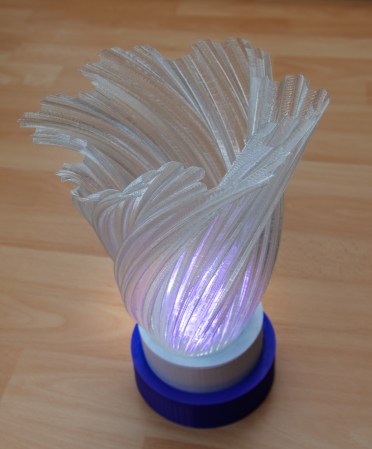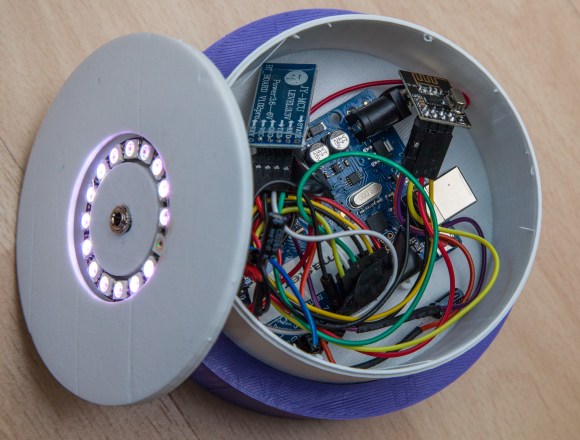

[Rob] created these amazing Bluetooth controlled LED lights for his daughter’s wedding adding a colorful ambient glow to the ceremony. Each item held a Neopixel ring and an Arduino microprocessor with a wireless module that could be individually addressed over a ‘mini-network.’ The main master station would receive commands from a Windows Phone. Usually we see Arduino-based projects being run with Android apps, so it’s nice to see that Microsoft is still present in the maker community.
The enclosures and translucent vases that sit atop the devices were 3D printed. All eight of the matrimonial units synchronized with each other, and the colors could be changed by sliding the settings bar on the app. [Rob] says that it was a lot of fun to build, and jokingly stated that it kept him “out of all the less important aspects of the ceremony. (food choice, decor, venue, who to marry etc etc).” The outcome was a beautiful arrangement of tabletop lighting for the wedding. A demo of [Rob]’s setup can be seen in the video below.















“it’s nice to see that Microsoft is still present in the maker community.”
– No it’s not.
All the innovation with Kinect hacking begs to differ
No, the innovation happened because some super smart FOSS guys reverse-engineered a driver for Linux, which I might add was better than the one Microsoft later released for Windows. Microsoft in that regard was and is merely an OEM for a depth-sensing camera, no different than Honda being an OEM for a go-cart motor.
AMEN… +1 ;^)
You used OEM in place of RESELLER. Microsoft did not invent kinect they simply bought a company that invented it.
As Redmond has done multiple times before.
Did someone mention Apple ?…
They were pushing a robotics scripting language thing a while back, I wonder what happened to that.
Visual Studio is great and the .Net framework is great. I’d love to see more projects that make use of it. For now though it seems to be in the sole domain of business desktop and web development.
Great idea, and good to see a project utilising a different platform (for a part of it) for a change. The 3D printed containers turned out really nicely too :)
Hmm, no code sharing for the arduino devices. I’m interested to see if he set up one as a master that then talked to the rest of the lamps or was the phone talking to all 8 BT modules directly. OR what I would expect a mesh network so that you would not have any range issues.
If you actually watched the video, you’d see he made it extremely clear that there was a master light. The master has bluetooth serial attached and what appears to be an nRF module.
Not very robust though; if the master goes down they all go down.
How many weddings does he go to each day?
PRO DAD.
A really useful project thank you and very useful to see the phone source code!
I think hackaday need to control the trolls. It seems that Arduino and Microsoft users are unable to post here without the trolls making irrelevant comments. It makes me wonder if hackaday are bias in allowing these constant negative and unhelpful comments. Surely everyone is allowed to use the hardware and software that they enjoy without forcing their views on others?
Hackaday, please get your house in order!